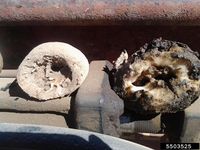Globisporangium ultimum
| Literature database |
|---|
| 412 articles sorted by: |
| • year (descending) |
| • research topics |
| • countries/regions |
| • host plants |
| • list of antagonists |

Author(s): Yanmin Zhu, Melody Saltzgiver and Jingxian Zhao
Source: American Journal of Plant Sciences (2018), 9, p. 2200
Globisporangium ultimum (Trow) Uzuhashi, Tojo & Kakish. 2010
This oomycete is a common soilborne root pathogen with a world-wide distribution. It causes damping-off and root rots on a large variety of crops under moist and warm conditions. Economically important damage is caused, for example, to turfgrass (Pythium blight), cucumber, carrot, wheat and maize. Above-ground symptoms include stunting, chlorosis (resembling nitrogen deficiency) and wilting. Often seedlings are specially affected.
The pathogen persists as durable oospores which can survive in the soil for more than 10 years. It disperses mainly through contaminated water. The hyphae are in general aseptate and produce spherical sporangia, around 20-30 µm in diameter. These germinate directly and do not form zoospores. Oogonia are spherical with a smooth surface and about 25 µm in diameter. They form a thick-walled oospore, about 20 µm large.
Synonyms
Pythium ultimum
- Other images of Globisporangium ultimum (IPM Images - click to enlarge)


